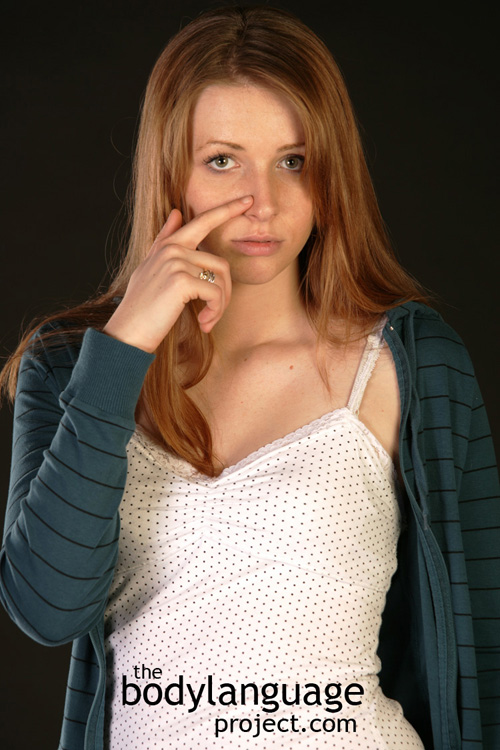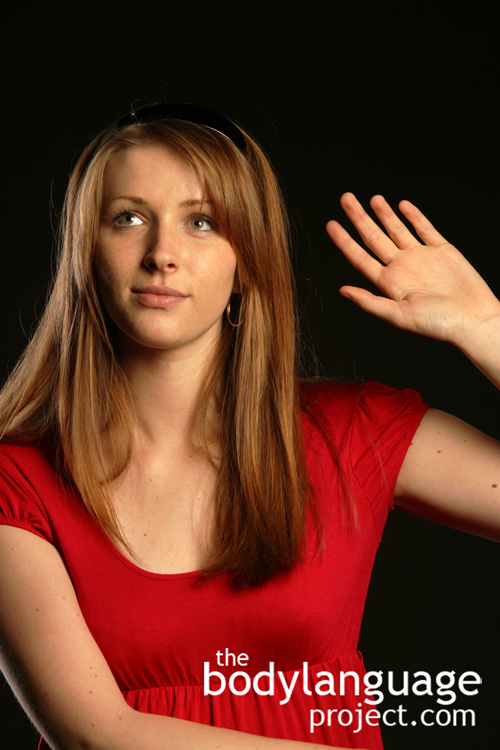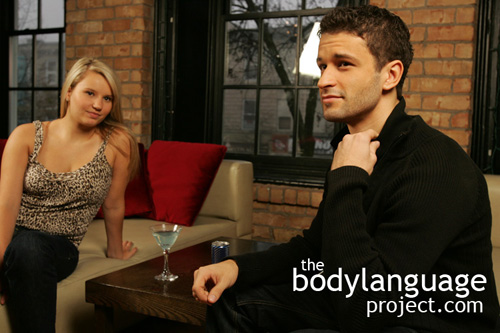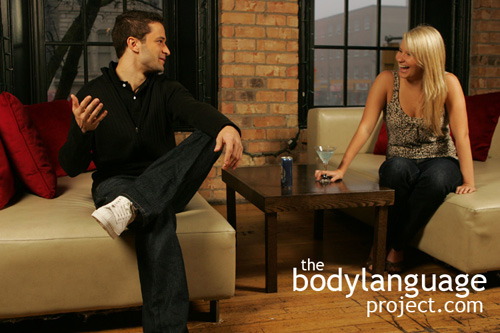In this chapter we looked in depth about space or territory and how it influences body language. We learned that the term applied to how people use space is proxemics and it includes personal space, distance norms, how cultures and regionality such as rural and urban centers are reflected in personal space, and how they relate to status and context. We learned why people turn into zombies in crowded city streets, how eye contact can control intimacy and why we should respect people’s personal space comforts no matter where they hail. We then played the urinal game and showed how space ties together with this ritual, and finally we covered indicators of invasion which can help us in respecting space limitations when in novel situations, or when around new acquaintances.
Tag Archive for Body Language
Summary – Chapter 3
by Chris Site Author • March 5, 2013 • 0 Comments
In this third chapter we examined and compared the various influences on body language: genetic, learned and cultural. We found that in terms of genetics we all show similar roots and so display similarly across cultures, but that learning does play a role in how we might signal. We also covered emblems, illustrators, affect displays, adaptors and regulators which all form a part of what is called kinesics or how nonverbal behaviour relates to movement. Emblems, we found, are quotable gestures that are culturally specific which can be used as replacement for words and have a direct verbal translation. Illustrators are a second type of gesture that we use while speaking to help us paint a more descriptive picture such as talking about a boxing match and using a punching motion. Affect displays is nonverbal language that reveal our emotional state such as smiling or frowning and adaptors are movements or gestures that are used to manage our feelings or control our responses such as postural changes. Sometimes these adaptors have hidden meaning, but other times they do not, so caution is warranted. Regulators on the other hand control turn taking and flow when people speak with one another. Finally we covered high and low context cultures as it relates to touching and the ways various cultures meet and greet one another.
Culturally Our Bodies Are All Basically The Same!
by Chris Site Author • March 5, 2013 • 0 Comments
Most researchers agree that the following six emotions are recognized by all cultures: happiness or enjoyment, distress or sadness, anger, disgust, surprise and fear. However, positions the body takes on to demonstrate these emotions vary across cultures. Since every person on the planet regardless of race or creed has the same underlying emotions and our body language is tied to our feelings, it follows that every person’s nonverbal language has similar roots, but like verbal language we don’t express ourselves exactly the same. Paul Ekman from the University of California has done extensive research into facial emotion recognition and has found just that, everyone across the planet is almost the same.
Happiness, sadness, and disgust had the best agreement between cultures, whereas fear and surprise tended to be confused, especially by the Japanese. Another rural population, the Dani people of West Iran, who are generally isolated from the rest of the world, showed a similar confusion between fear and surprise. Surprise is read as a straight upward lift of the forehead whereas fear engages the muscles between the brows folding them. The French call the area between the brows, the “grief muscle” and is active to express both pain, as well as when you wish to inflict it. The fearful face carries a momentary raise in the upper eyelids and a grimace comes across the mouth. Anger appears with a lowering of the eyebrows, flaring of the eyes and a tightening of the mouth or jaw. Fear, grief and surprise in addition to other facial expressions can quickly flash across the face in the form of micro expressions. Being aware of them can rouse opponents and in poker indicate ‘tells.’ As people check their hidden cards, be sure to watch for split second reactions.
Members of the Fore linguistic-cultural group of the South East Highlands of New Guinea whom had never seen movies, who did not speak English and had never worked with a Caucasians before were also able to read facial expressions accurately. Studies show that even blind children score similarly to sighted children in terms of facial expressions. Further research by Paul Ekman showed that a contempt expression was also none culturally specific and was recognized by Estonians, Germans, Greeks, Hongkongese, Italians, Japanese, Scotts, Turks, Americans and West Sumatrans. Ekman traveled to a remote population in the mountains of Papua New Guinea where there is no television, DVDs or movies yet found that facial expressions remain universally understood. Once there he filmed the expressions of the population and found that upon his return were also understood by Westerners.
With very little exception, facial expressions are universally recognized. What does differ from culture to culture is our surroundings; our habitat and traditions. Greater differences therefore lie in our territoriality, level of eye contact, and touching norms. These factors tie back into the density in which we reside, and also into our comfort tolerances and preferences due to our upbringing. Gestures are mostly learned and passed from one person to another and are thus not universal across cultures. Gestures are more similar to verbal language. Because language and gestures are transferred over time they also evolve.
How To Use Regulators
by Chris Site Author • March 5, 2013 • 0 Comments
Regulators, regulate speech and control turn taking. Literally we can increase or decrease the amount of talking that happens with simple body language. For example, to increase speaking add more nodding. When people stop and you wish for them to continue simply nod your head, and, more often than not, this will encourage them to begin speaking again. The use of “mhums” and “yeses” will have the same effect. To speed speech up, or end a conversation altogether, send frequent looks away or down to your watch.
Too much nodding, on the other hand, shows indifference which can be a useful tactic depending on the speaker and your intent. Three nods in quick succession shows that you are ready to speak yourself and has the net effect of increasing their rate of speech to avoid being cut off. Drawing in air and parting the lips while tilting the head back slightly also gives the impression that someone is prepared to speak, as does patting the mouth with two fingers. Looking at your watch or looking to the doorway will make people talk less or if done excessively stop altogether.
Try this experiment. As your conversation begins nod your head every few seconds or as you see agreement. Next, increase the rate at which you nod your heard regardless of any agreement. What happens when you increase your nod frequencies? Most likely, up to about two to three continuous nods, they will become more excited believing they are building rapport. What if you nod continuously? I suspect it will stop the conversation altogether. Recall that three quick nods means that you wish to interject, while continuous nodding comes across as feigned agreement sending the conversation into a standstill. What happens with appropriate nodding absent of proper eye contact? This signals to others that their conversation is falling on deaf ears, and will be taken as an insult. The same goes with random nodding that has lost synchrony with speech. Telephone conversations easily fall off their rails if one party becomes preoccupied with another task. We immediately sense that their regulators have become unlinked from the conversation and when it comes time for them to speak, we hear nothing in return, or there is a delay. Not surprisingly, we find that the person on the other end is watching television – an obvious insult.
When people near the end of their though, and wish for their partner to speak, they will often lower their volume and slow their voice down slightly. Other times, the final syllable will be drawn out or gesturing with the hands will become less frequent or stop altogether. The eyes too are often lowered along with the head but at the very last moment eye contact will resume indicating that it’s time for the other person to begin speaking.
Raising the index finger can also signal a desire to speak which we learn early on in grade school which is normally accompanied by a sharp and deep intake of air. To stifle the “index finger interjector”, extend your hand across and make light contact with their forearm. This is a polite nonverbal way to show that you acknowledge their desire to speak, but that you haven’t quite concluded your point. If you sincerely wish to communicate interest and increase speaking, add a slight head tilt and a half frown or half-smile. This shows the speaker that what they have said is unclear but that you otherwise find it fascinating and wish to learn more.
Good communicators will make great partners amongst all types of speakers, even those that seem to carry on endlessly or those with little to say. They will have a strong arsenal of tools to cut one set of speaker off nonverbally, or as the case may be, encourage them to speak further. While we may take regulators for granted, conversations would be awkward and disjointed without them. Experiment a little for yourself and see how you can modify behaviour with regulators to suite your needs.
Regulators, Regulate Speech
by Chris Site Author • March 5, 2013 • 0 Comments
The final type of gestures are called regulators because they are used to modulate and maintain the flow of the speech during conversation. Essentially, we use regulators to control turn-taking in conversation and they can take the form of kinesic such as head nods or nonkinesic such as eye movements. Regulators are different across cultures more so than any other element of body language discussed thus far.
In a study by Marjorie Vargas in 1986, it was noted that black students in the United States felt insulted by the white educators. The educators weren’t picking up on cues that the students understood what was being instructed. For example, the white students would nod and murmur “uh-huh” but the black students would nod much less and use “mhm” instead. The teachers took this to mean that the students didn’t fully understand the material, but this wasn’t so, they just expressed their understanding differently.
In Japan, the up and down nod of the head or “yes motion” is utilized not to show ‘agreement’ but to show ‘understanding’. Therefore, while pitching a new idea or venture, it would be foolish to think that the continuous head nodding by the Japanese was do to their willingness to invest. Creating a simple dos and don’ts list is not feasible for these nonverbal kinesics in speech for the simple fact that there are far too many to list and the variation of meaning across culture is so varied. With the simple awareness of emblems, illustrators, affect displays, adaptors and regulators the incidence of misinterpreting their meaning can be reduced.
Caution is therefore important when dealing with international business so as to avoid any harm in interpretation. Some other examples of regulators include putting the hand up to signal that you are ready to speak, putting the finger up to the mouth to bring silence, waiving the hand around in a circle so as to speed things up, rolling of the eyes showing disapproval, a gasp to show shock, throwing the hand to someone to include them in the conversation, or shaking the head disapprovingly. All these gestures control the flow and pattern of speech by directing, disapproving, speeding things up or slowing them down, and even cutting the speaker short.
Using regulators in speech is necessary to create seamless turn-taking and to avoid appearing rude, dominating or frustrating the people you are talking with. It prevents having to interrupt, eases the flow of speech and allows everyone to make the points they wish to make without having to cut each other off mid-sentence. The net effect of a good conversation is connectivity through the creation of seamless turn-taking.
Adaptors
by Chris Site Author • March 5, 2013 • 0 Comments
Adaptors are movements or gestures that are used to manage our feelings or control our responses. Adaptors include movements done to improve comfort or reduce stress and often happen at such a low level they usually escape awareness. Adaptors include movements such as shifting in a chair or postural changes, crossing the legs, pulling at a shirt collar, adjusting a tie, loosening clothing and so forth.
What is interesting to researchers is that some adaptors serve a real purpose and others indicate stress. For example, sometimes our pants really are uncomfortable so we scratch our legs, other times the stress from outside pressure causes us to scratch in an effort to displace energy and distract us. Crossing the legs toward your date might be read as an indicator of interest, but might instead serve to alleviate numbness from loss of circulation. Children will rub their eyes repeatedly when tired, but this is not because they become itchy!
Scratching the nose is another example of an adaptor and could be misread as an indicator of a lying or might actually serve to relieve an itch. Another common adaptor used by adults is the head-grooming gesture where the hand messages the back of the neck or head to relive stress. This gesture is not an authentic gesture motivated by a physical purpose. Rather it used as a method to achieve comfort when facing discomfort applied from the outside. Just about every cue related to body language can be an adaptor. Arm crossing, leg crossing, scratching, fidgeting, twitching, rubbing the eyes, and so on, are all part of the human repertoire and not all have hidden meaning all of the time.
It is the job of the body language reader to decide which movements are motivated by a real physical purpose and which are motivated by an underlying emotional purpose. Usually stress release methods are person specific so once they are detected can be reliable as predictors in future encounters. Some might pull an ear lobe, rub one’s throat, pull on a collar or scratch the back of the hands. I will say that it’s usually pretty obvious when a gesture like scratching is real because it is targeted, quick, non-repetitive and provides instant relief, but when it’s as a response to emotional trauma, it show opposite characteristics. It is general in nature, perpetual, repetitive and provides no discernable relief (at least not instantaneously). The context, meaning high or low stress environment provides strong clues to the purpose of the adaptors. All proper body language reads should take context into consideration.
As we see, movements or adaptors come in two forms. They either have hidden meaning, or they do not. Plenty of emphasis has been given by researchers on these subconscious clues on the grounds that they would unlock secrets. However, the importance placed on adaptors is probably overstated and oversimplified. The real goal of the body language reader is to decipher the difference between adaptors with no meaning and movements and gestures that have actual meaning. Adaptors in cross-cultural meetings can also be potential landmines. For example, emblems, specifically because they are culturally engrained, are emitted without conscious thought. Many Arabic countries see the sole of the foot or the figure-four-leg cross as offensive and rude (an emblem of sorts to them) so they may classify a Westerner as something they intent not to be. It is clear to the Westerner that they wish only to take up a more comfortable seating position. The take-away message is to treat adaptors with the care they deserve instead of jumping to inaccurate, embarrassing or even disastrous conclusions.
Recognizing Body Affect By Culture
by Chris Site Author • March 5, 2013 • 0 Comments
In 1969 researchers Albert Mehrabian and John Friar found that a person’s state, their mood, and their emotional state were reflected by changes in body positions. In this context we are referring to affect in terms of simple gestures like leg crossing and arm crossing to indicate a closed mind or palms up and arms uncrossed to show openness or a willingness to listen. In fact, most of this book covers body affect and systematically breaks it down in future chapters. This cultural discussion is therefore important in that it describes the universality of body language.
While little research has focused specifically on measuring emotion from body positions, it has been found that the central nervous system is responsible for perception of emotion and this emotion is fed back into our body’s machinery to produce affect. The ways in which people convey emotion through body positions (or affect) is mediated by many factors including age, gender and context. Despite these factors though, body positions due to emotion, also has a cultural component. It is generally agreed that the face holds particularly universal expressions in terms of emotions as mentioned in the previous section, but the remaining language spoken by the body seems less obvious.
For example, the Japanese tend to be less expressive with their body language overall and therefore rate others more intensely on their nonverbal language. In a 2006 study by Andrea Kleinsmith and her colleagues out of London it was found that even mild expressions were rated as more emotional by the Japanese subjects over the ratings of other cultures on the same affect. A Westerner in the eye of the Japanese appears like a flailing uncontrolled windmill with their arms moving about as they gesticulate while they speak, whereas the Japanese appear rigid and uptight to a Westerner. In the study however, the meaning behind body language was still rated similarly across all cultures showing that emotion does have universal traits and crosses cultures. Thus, while the amount of affect does vary across cultures, the meaning behind the body language crosses boarders.
Emblems, Illustrators, Affect Displays, Adaptors And Regulators
by Chris Site Author • March 5, 2013 • 0 Comments
Gestures are used in speech to convey information more efficiently or to express attitudes or emotions and as a body language reader they give us clues as to the speakers mental framework from which they speak. Beneficial byproducts of gestures include making speech occur more smoothly and increased liking between speakers and listeners. In the following section we will cover “kinesics” which is the subclass of nonverbal body language that is related to movement. Kinesics is probably the most talked about and most common type of body language but also the most easily confused cross-culturally.
The first full length study on gesture was published in 1644 by John Bulwer. He catalogued dozens of gestures and produced a guide on how to increase clarity and eloquence in public speaking. Further research has shown that some gestures are universal and therefore have ubiquitous meaning across cultures, while others only have local meaning. Other gestures are context specific so mean one thing in one place and can mean something entirely different elsewhere. Pointing, made by extending the index finger and balling up the rest of the hand for example, is one of the gestures that has the same meaning everywhere, but the okay-sign made by touching the index finger to the thumb and flaring out the remaining fingers, as we shall see later, does not.
Some cultures also tend to gesture, called “gesticulation” when used in speech, more or less often than others. For example, Italians are known to use a lot of gestures in speech whereas the English tend to use gestures infrequently. The English culture, on the other hand, deems high rates of gesticulation as being impolite. The high gesture cultures include Hebrew, French and Spanish.
The more social way for us to use our hands is to use them in concert with what is being said, although taken to extremes like the Italians, or lack thereof like the English, can be counterproductive. A balance between the two, will be the best case. The hands and arms add to the dialogue and liven it. Keeping your hands to your sides or your arms crossed tightly might be comfortable, but those that use their hands moderately while speaking appear intelligent and honest when viewed by others. Universally, closed posture come off as negative and anti-social no matter what kinds of truths spoken or positive feelings intended by the speaker. This is why it’s so important to be conscious of our gestures because even if we aren’t, others will be. Whether or not others bring closed body language to consciousness, is not relevant. Our impressions are created in others passively with no active thinking.
The various gestures have been broken down into five categories: emblems, illustrators, affect displays, regulators which we cover next.
Introduction – Chapter 3
by Chris Site Author • March 5, 2013 • 0 Comments
If you spend time traveling or do business in more than one country then this chapter will prove invaluable. Not all body language happens the same way all over the world. To some this revelation gives them ammunition against body language because they say that since it is not totally universal, it is not innate and therefore not predictive, however this is not so. While some body language crosses culture, other language does not, what is important though, it to know which is which. We will spend the following chapter looking at how body language varies from region to region and hence from culture to culture and you will see that some body language is learned while some innate or genetic.
As we progress we will look at how emblems, illustrators, affect displays, adaptors and regulators add colour to our language and as how to use them. We will also discuss how these facets of body language vary across regions. The two take-away messages from this chapter is that it is the sender that determines the accuracy of the message no matter what the culture, and that it is up to you to decide what it means, and that it is the culture in which we find ourselves which dictates what’s normal. In this context, normal is what tells us how we should comport ourselves. We will see that our innate body language dictates our culture, that some gestures are universal (and some are not) and that touching preferences and desire (or tolerance) to closeness is learned. Finally we will cover the ways in which cultures meet and greet one-another.
Body language And Energy displacement
by Chris Site Author • March 5, 2013 • 0 Comments
When someone talks about energy displacement and body language they are talking about movements that create relief. Someone that is nervous or excited will find relief in rubbing their legs with their hands called “leg cleansing”, or they might rub their hands together or stroke an object vigorously. Leg cleansing is a gesture that usually goes unnoticed because it happens underneath the table, but an astute observer will see the upper body move serving to give it away. An example of leg cleaning is that of a baseball player that is on deck and getting ready to bat. His hands might be sweaty from the excitement so he rubs his hands on his thighs, soon enough this becomes a habit and he does this every time he comes to bat regardless of whether his hands are sweaty. With repetition he has conditioned himself to seek comfort by performing this gesture. Self touching also produces relaxing chemicals in his body to help him deal with the stress and burns up nervous energy. Self touching isn’t always related to energy displacement although in this case it is. Energy displacement means the same thing as stress motivated energy burning. It is the burning of energy that provides a trickle release that occupies the mind and produces soothing neurochemicals.
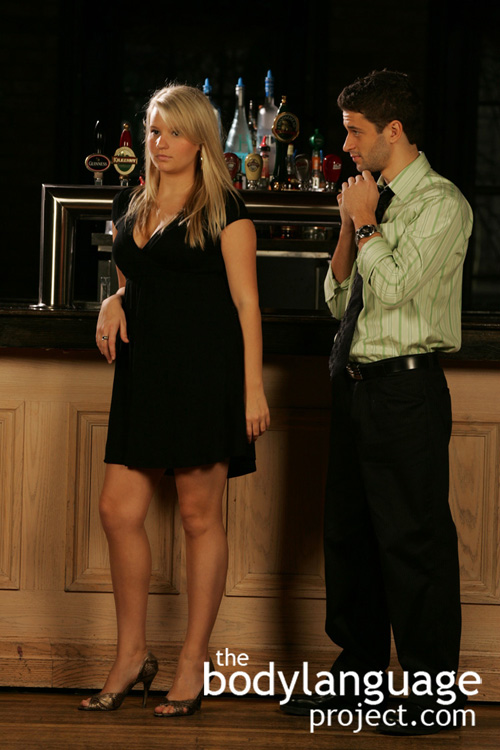
Extreme anxiety causes the desire to control the pain by inflicting it against ourselves. It gives back our sense of control. People who resort to ‘cutting’ also seek to displace their anxiety and control it.
Energy displacement isn’t just for athletes, it happens all over the place from the boardroom to the classroom. We see people rubbing their hands together in excitement or wringing their hands showing inner turmoil and in during extreme stress, pacing, or even self inflicted pain such as ear pulling, scratching, or pinching. Energy displacement allows for a controlled release of tension without creating fatigue. Energy displacement is akin to the natural high that is achieved through punishing physical exercise except in this case the endorphin rush comes much less potently but the action still provides a stress reducer.
When a woman suddenly becomes “cold” as a decision gets close in a meeting they might begin by cross their arms and begin to stroke their elbows or forearms. The temperature in the room hasn’t dropping though, what she is feeling is an emotional change creating an uneasy feeling. To sooth herself, she strokes her body and this reminds her of childhood feelings where mom comforted her. A nervous husband who waits outside a delivery room will pace back and forth. His movement gives him something to do and also burns up excess energy. Generally men’s displacement actions will be easier to spot then women’s since they will be more aggressive. Men feel that when something is good, more is better, and take almost everything to extremes. In fact, one of the leading causes of preventable gum disease is brushing the teeth too hard or for too long, and men are often most at fault for this. Women’s postures, on the other hand, will melt into their regular body language and can therefore be harder to spot.
An entire host of gestures can be used for energy displacement and they vary from person to person and culture to culture. Any movement that has no inherent or immediate function and that is done when faced with stress can be called energy displacement. With observation, you can catalog energy displacement cues in family members, friends and even bosses. If you observe energy displacement body language in friends, an appropriate response is to offer comfort, but if it is found in a boss or employee, or during a sale, then it is usually time to back off and give them time to think things over. Allow a stressed out individual some time to reach a conclusion on their own.

